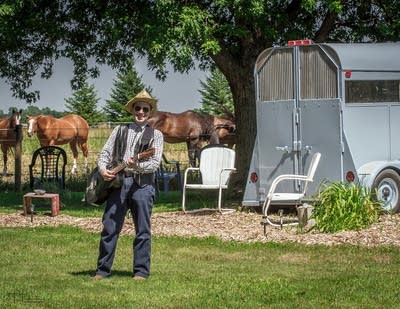Music among horses: artist AJ Scheiber and This Old Horse sanctuary soothe animals with songs
by Hanna Bubser
July 12, 2017

The power of music is ingrained in us. There is a song out there for every single mood or moment. As a result, people often choose to utilize music for a span of physical and cognitive needs. Knowing what we humans do about the existence of emotion and need for support, would it be that surprising to discover that animals benefit from the effect of music as well?
It is more common than you may think, especially with animal sanctuaries and rescue facilities. Such an instance is evidenced in this video, posted to Facebook by the Care for Wild Rhino Sanctuary based in Mpumalanga, South Africa. In it, employee Mark Mills strums a guitar for a baby rhino who was rejected by her mother. The music soothes her and puts her to sleep.
But rhinos are not the only animals who benefit from this. In fact, we can see it happening right here in Minnesota. This Old Horse of Hastings, Minn., is a "volunteer-based, nonprofit organization whose mission is to provide sanctuary to retired, rescued, and recovering horses while they continue to serve as ambassadors to the positive effect of 'horse power' in the lives of people." One of the ways that it achieves this goal is by enlisting the help of music. Namely, the music of one AJ Scheiber.
Scheiber, a local musician who is also a University of St. Thomas English professor, played at This Old Horse for a fundraiser event earlier this spring alongside his band Wilkinson James. When the opportunity to perform his music among the horses was presented to him, how could he say no? But Scheiber is understandably much more used to playing to crowds of humans rather than animals; so how exactly did he prepare for an equine audience? "I took a couple of different guitars that have different tonal properties, to see which sounds the horses seemed to like best." Scheiber says. "Honestly, in some ways it as not that different from playing a bar or a coffeehouse — some preferred to keep their distance and do their own thing, some were aware of my presence (and maybe the music's presence) intermittently, and some were really interested and got up close."
Toni Thomas, a member of the board of directors and a photographer for This Old Horse, said that the idea for this experiment was somewhat inspired by her own tendency to play music while she photographs the horses. "I feel music is such a powerful universal communication among all living beings," Thomas says. "If it can move me can it move horses?"
Thomas had already observed a connection between animals and music once before. "I came across some cows one day behind the fence but very close to the road," she recalls. "So I pulled over and turned up the music I was playing — classical — and they all looked up and many of them just kinda lined up right at the fence staring. There was just something about it."
During AJ's session, she noticed that one horse named Misko, whom she described as standoffish, moved "up very close to AJ, slowly, almost touching him, and just stood there calmly. Something was going on there." She says that she went into this performance with no real expectations, and was "touched and thrilled to see a type of music bring a reaction."
Scheiber describes this as a "challenge … making music in the presence of creatures to whom I had to be very attentive and sensitive … but it didn't take long to feel at home in their midst."
It involves music and understanding between species, which is truly like any other musical performance. The horses at This Old Horse have been through a myriad of hardships from neglect to loneliness. The music provides a chance for them to connect with a human in a safe environment.
Thomas believes that the horses were able to sense this feeling of comfort from AJ and his music:" … perhaps that is why they surrounded him … they felt his calmness and heard his music."
One study for the Empirical Musicology Reviewshowed that domestic horses can build a response with music and the help of their trainer that gives them the ability to synchronize their own rhythm to that of the music. This becomes a form of "vocal learning and rhythmic synchronization" with the animal, and reveals that not only do horses respond well to music, but they can form a deep relationship with it.
Scheiber experienced what seemed like a breakthrough during his day at This Old Horse: "At one point, one of the horses leaned down and flicked the guitar strings with his tongue, almost as if he was trying to strum it. That was probably the most amazing moment for me."
Thomas would love to do more performances like Scheiber's in the future with different instruments, to see how the horses will react. "The biggest [takeaway] for me is watching the reactions of the horses and the experience of watching them react to the sounds," Thomas says. "There's just something inside that make my heart happy."



